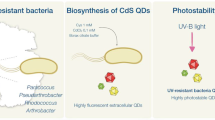Abstract
Difference spectra of the crude cell-free extract ofAzospirillum brasilense sp. 7 indicate the presence of cytochrome b, cytochrome c, and one CO-binding pigment that exhibits the spectral characteristics of cytochrome o. All the pigments are present in varying concentrations at all stages of growth. With progress of the bacterial growth, there is a linear increase in the level of cytochrome b with a disproportionate increase in the level of cytochrome c. At the stationary phase, the amount of cytochrome b and c is increased by about sevenfold compared with that in the early log phase. The increase in the concentration of total cytochrome is not accompanied by an increase in the respiration rate of the cells. Both cytochrome b and cytochrome c are located in the particulate fraction of the cells and are not fully reducible by succinate alone.
Similar content being viewed by others
Literature Cited
Döbereiner, J., Day, J. M. 1975. Associative symbiosis in tropical grasses: characterization of microorganisms and dinitrogen fixing sites. International symposium on N2 fixation: interdisciplinary discussions 3–7 June, 1974, Washington State University. Washington State University Press, Pullman, WA.
Okon, Y. Houchins, J. P., Albrecht, S. L., Burris, R. H. 1977. Growth ofSpirillum lipoferum at constant partial pressures of oxygen, and the properties of its nitrogenase in cell-free extracts. Journal of General Microbiology98:87–93
Kamen, M. D., Horio, I. 1970. Bacterial cytochromes. I. Structural aspects. Annual Review of Biochemistry39:673–700.
Williams, J. N. 1964. A method for the simultaneous quantitative estimation of cytochromes a, b, c1 and c in mitochondria. Archives of Biochemistry and Biophysics107:537–543.
Appleby, C. A. 1969. Electron transport systems ofRhizobium japonicum. II. Rhizobium haemoglobin, cytochromes and oxidases in free-living (cultured) cells. Biochimica et Biophysica Acta172:88–105.
Jones, C. W., Redfearn, E. R. 1966. Electron transport inAzotobacter vinelandii. Biochimica et Biophysica Acta113:467–481.
Wolfe, R. S., Pfenning, N. 1977. Reduction of sulfur bySpirillum 5175 and syntrophism withChlorobium. Applied and Environmental Microbiology33:427–433.
Clark-Walker, G. D., Rittenberg, B., Laschlles, J. 1967. Cytochrome synthesis and its regulation inSpirillum itersonii. Journal of Bacteriology94:1648–1655.
Cole, J. A., Rittenberg, S. C. 1971. A comparison of respiratory processes inSpirillum volutans, Spirillum itersonii andSpirillum serpens. Journal of General Microbiology69:375–383.
Romanov, V. I., Matus, V. K., Korolev, A. V., Kretovich, V. L. 1973. Influence of oxygen conditions on the respiration and cytochrome composition inRhizobium leguminosarum. Mikrobiologiya42:976–982.
Faller, A. H., Schleifer, K. 1981. Effects of growth phase and oxygen supply on the cytochrome composition and morphology ofArthrobacter crystallopoietes. Current Microbiology6:253–258.
Lowry, O. H., Rosebrough, N. J. Farr, A. L., Randall, R. J. 1951. Protein measurement with the folin phenol reagent. Journal of Biological Chemistry193:265–275.
Smith, L. 1978. Bacterial cytochromes and their spectral characterization. Methods in Enzymology53D:202–212.
Herbert, D., Phipps, P. J. Strange, R. E. 1971. Chemical analysis of microbial cells. Methods in Microbiology5B:249–252.
Poole, R. K. 1983. Bacterial cytochrome oxidases: a structurally and functionally diverse group of electron-transfer proteins. Biochimica et Biophysica Acta726:205–243.
Omura, T., Sato, R. 1964. The carbon monoxide-binding pigment of liver microsomes. I. Evidence for its hemoprotein nature. Journal of Biological Chemistry239:2370–2378.
Castor, L. N., Chance, B. 1959. Photochemical determinations of the oxidases of bacteria. Journal of Biological Chemistry234: 1587–1592.
Iaber, H. W., Morrison, M. 1964. Electron transport inStaphylococci: properties of a particle preparation from exponential phaseStaphylococcus aureus. Archives of Biochemistry and Biophysics105:367–379.
Ianiguchi, S., Kamen, M. D. 1965. The oxidase system of heterotrophically grownRhodospirillum rubrum. Biochemica et Biophysica Acta96:395–428.
Jacobs, N. J., Conti, S. F. 1965. Effect of hemin on the formation of anaerobically grownStaphylococcus epidermidis. Journal of Bacteriology89:675–679.
White, D. C. 1967. Effect of glucose on the formation of the membrane-bound electron transport system inHaemophilus parainfluenzae. Journal of Bacteriology93:567–573.
Author information
Authors and Affiliations
Rights and permissions
About this article
Cite this article
Chakrabarti, S.K., Mishra, A.K. & Chakrabartty, P.K. Cytochromes inAzospirillum brasilense . Current Microbiology 11, 343–347 (1984). https://doi.org/10.1007/BF01567703
Issue Date:
DOI: https://doi.org/10.1007/BF01567703




